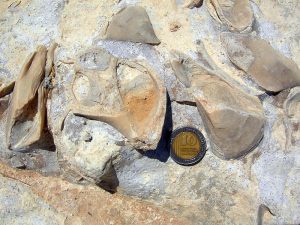Welcome! There is such wonderful paleontological material on the Web. Come here often! I’ll assume from the start that you all know the Geologic Time Scale, which will be critical to all that we do in this course. Here is the geological-time-scale I consider authoritative in our classes. You will be referring throughout the semester to our course’s “Systematics” pages, sometimes called “the yellow book,” for the print-out you’ll receive in class. It is the same as this online pdf version.
Here are a few general links to paleontological resources to get us started. I will be using the University of California Museum of Paleontology (Berkeley) site often because it is very, very good. Here is their page on “learning from the fossil record“, with numerous educational and professional articles and links. The Paleontological Research Institution has an excellent site with introductory material (including “mystery fossils” to identify). It is oriented towards professionals and graduate students, but you can certainly have a go at it. Who knows — maybe a research paper topic is lurking in there? And I can’t let you go without links to my favorite organizations: The Paleontological Society and The Palaeontological Association. You certainly want to look at the projects of Wooster paleontologists over the past few years. You may also want to visit The Paleontology Portal which is “a central entryway to paleontology on the Web”. It is an excellent link to thousands of paleontological resources. (Check out their fossil gallery, which is organized by period.)
Virtual museums are the latest web rage. Here’s a fossil museum from Valdosta State University in Georgia. It is very good for some taxa, but not for many invertebrates (like my favorite little bryozoans). The Virtual Fossil Museum is one of the first of its kind. Eclectic, and I’m not sure who operates it, but it has many excellent photographs.
As far as this week’s material goes, the Web is often more misleading than helpful on the topic of fossil preservation. Many common terms (like mold and cast) are misused. The Wikipedia section on fossil preservation may be our best start.
The new Time Scavengers blog is an excellent resource for geology students, especially those interested in paleontology. University of Tennessee graduate students Jen Bauer and Adriane Lam have put together a fantastic collection of articles, teaching aids, and links just for students like you!
Our theme song!

Jurassic fossils in southern Israel (Matmor Formation, Makhtesh Gadol, near Dimona). Click for larger view.
Geology in the News —
A top-ten list of the best fossil finds of 2016. Sadly, my work did not make the cut!
There are wildfires in Greenland this month. That alone says much about climate change. Be very afraid.
The new record holder for the largest dinosaur is Patagotitan mayorum from the Cretaceous of Argentina. This magnificent creature probably weighed over 70 tons and had a length of more than 120 feet.
